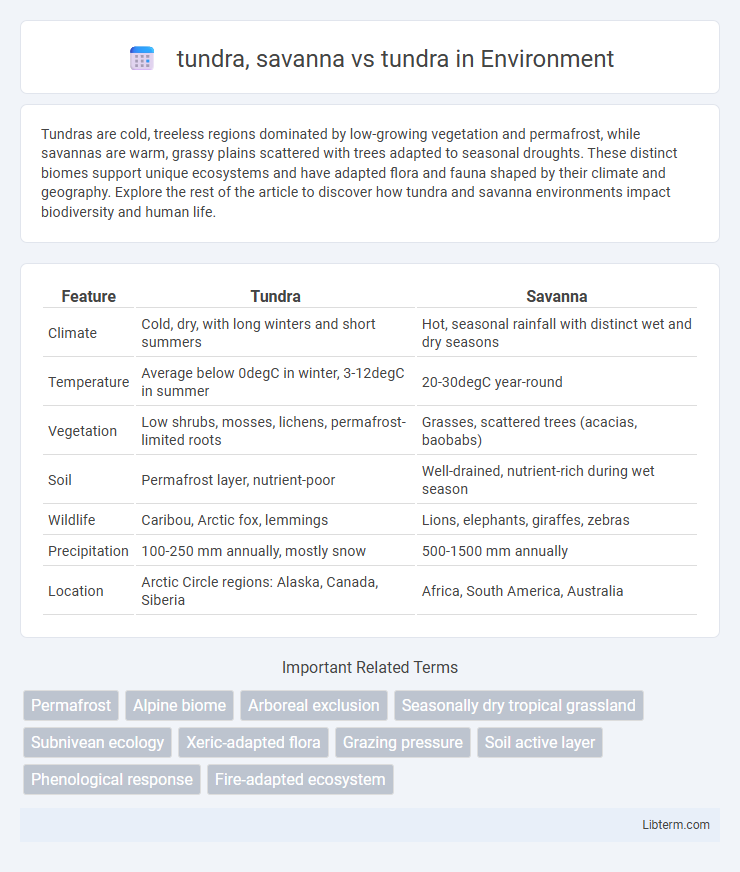Tundras are cold, treeless regions dominated by low-growing vegetation and permafrost, while savannas are warm, grassy plains scattered with trees adapted to seasonal droughts. These distinct biomes support unique ecosystems and have adapted flora and fauna shaped by their climate and geography. Explore the rest of the article to discover how tundra and savanna environments impact biodiversity and human life.
Table of Comparison
| Feature | Tundra | Savanna |
|---|---|---|
| Climate | Cold, dry, with long winters and short summers | Hot, seasonal rainfall with distinct wet and dry seasons |
| Temperature | Average below 0degC in winter, 3-12degC in summer | 20-30degC year-round |
| Vegetation | Low shrubs, mosses, lichens, permafrost-limited roots | Grasses, scattered trees (acacias, baobabs) |
| Soil | Permafrost layer, nutrient-poor | Well-drained, nutrient-rich during wet season |
| Wildlife | Caribou, Arctic fox, lemmings | Lions, elephants, giraffes, zebras |
| Precipitation | 100-250 mm annually, mostly snow | 500-1500 mm annually |
| Location | Arctic Circle regions: Alaska, Canada, Siberia | Africa, South America, Australia |
Introduction to Biomes: Tundra and Savanna
The tundra biome is characterized by cold temperatures, permafrost, and minimal vegetation such as mosses and lichens, supporting specialized wildlife like caribou and arctic foxes. In contrast, the savanna features warm climates with distinct wet and dry seasons, dominated by grasses, scattered trees, and large herbivores such as elephants and zebras. These biomes differ significantly in temperature, precipitation patterns, soil types, and biodiversity, reflecting adaptations to their unique environmental conditions.
Geographic Distribution: Where Tundra and Savanna Are Found
Tundra primarily exists in the Arctic Circle regions of North America, Europe, and Asia, featuring cold temperatures and permafrost. Savanna ecosystems are predominantly found in Africa, South America, and Australia, characterized by warm climates with distinct wet and dry seasons. The geographic distribution highlights tundra's adaptation to polar environments, while savannas thrive in tropical and subtropical zones.
Climate Differences: Tundra vs Savanna
Tundra climates are characterized by extremely low temperatures, limited precipitation mainly in the form of snow, and a short growing season, typically found in polar regions with permafrost soil. In contrast, savanna climates experience distinct wet and dry seasons, higher average temperatures, and moderate rainfall, supporting grasses and scattered trees in tropical and subtropical regions. These climate differences influence biodiversity and soil composition, with tundras supporting cold-adapted species and sparse vegetation, while savannas sustain diverse wildlife and more productive ecosystems.
Soil Composition and Fertility Comparison
Tundra soils are typically characterized by permafrost layers, low organic matter, and limited microbial activity, resulting in poor fertility and nutrient availability. In contrast, savanna soils often contain higher organic content and better drainage, supporting enhanced nutrient cycling and greater fertility despite seasonal dryness. The distinct soil compositions directly influence vegetation types, with tundra supporting primarily mosses and lichens, while savanna sustains grasses and scattered trees.
Distinct Flora: Plant Adaptations in Tundra and Savanna
Tundra vegetation primarily consists of mosses, lichens, and low-growing shrubs adapted to cold, nutrient-poor soil and permafrost, with plants exhibiting adaptations such as small leaves and shallow root systems to minimize water loss and withstand freezing temperatures. In contrast, savanna flora is dominated by drought-resistant grasses, scattered trees, and shrubs with deep root systems and thick bark, enabling survival through seasonal droughts and frequent fires. These distinct plant adaptations highlight the contrasting environmental pressures of tundra's cold aridity and savanna's heat and moisture variability.
Distinct Fauna: Animal Life in Tundra vs Savanna
The tundra hosts specialized fauna such as caribou, arctic foxes, and migratory birds adapted to cold, harsh environments with limited vegetation. In contrast, the savanna supports large herbivores like elephants, zebras, and wildebeests, alongside predators such as lions and cheetahs, thriving in warm climates with abundant grasses. These distinct animal communities reflect adaptations to extreme cold versus seasonal rainfall and open grassland ecosystems.
Seasonal Patterns and Weather Extremes
The tundra features long, harsh winters with temperatures often dropping below -30degC and short, cool summers lasting only a few months, resulting in limited vegetation growth and permafrost soil. Savannas experience distinct wet and dry seasons, with temperatures ranging from 20degC to 30degC year-round, promoting diverse grasses and scattered trees adapted to seasonal drought. Weather extremes in tundras include polar nights and constant sunlight depending on the season, while savannas face periodic droughts and unpredictable rainfall patterns influencing fire regimes and biodiversity.
Human Activities and Their Environmental Impact
Human activities in tundra regions, such as oil drilling and mining, disrupt fragile ecosystems and lead to permafrost degradation, releasing stored carbon and accelerating climate change. In contrast, savanna landscapes face extensive agricultural expansion and cattle grazing, causing soil erosion, habitat fragmentation, and loss of biodiversity. Both biomes experience significant environmental impacts from human-induced modifications, including altered carbon cycles and diminished ecosystem resilience.
Biodiversity: Richness and Conservation Status
Tundra ecosystems exhibit low biodiversity due to extreme cold and short growing seasons, supporting specialized, cold-adapted species like lichens, mosses, and migratory birds. Savannas display higher biodiversity with diverse grasses, shrubs, and large herbivores such as elephants, zebras, and predators like lions, reflecting richly layered trophic interactions. Conservation status reveals tundra habitats face threats from climate change causing permafrost thaw, while savannas are endangered by habitat fragmentation and overgrazing, necessitating targeted preservation strategies for both biomes.
Key Takeaways: Tundra vs Savanna Summary
Tundras are cold, treeless biomes with permafrost, supporting mosses, lichens, and low shrubs, while savannas are warm grasslands with scattered trees, thriving in tropical and subtropical regions. Tundras experience long, harsh winters and short growing seasons, contrasting with savannas' distinct wet and dry seasons that support diverse herbivores and predators. Key distinctions include tundra's low biodiversity and slow nutrient cycling versus savanna's rich biodiversity and active fire ecology.
tundra, savanna Infographic

 libterm.com
libterm.com